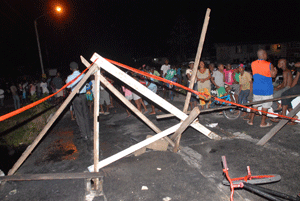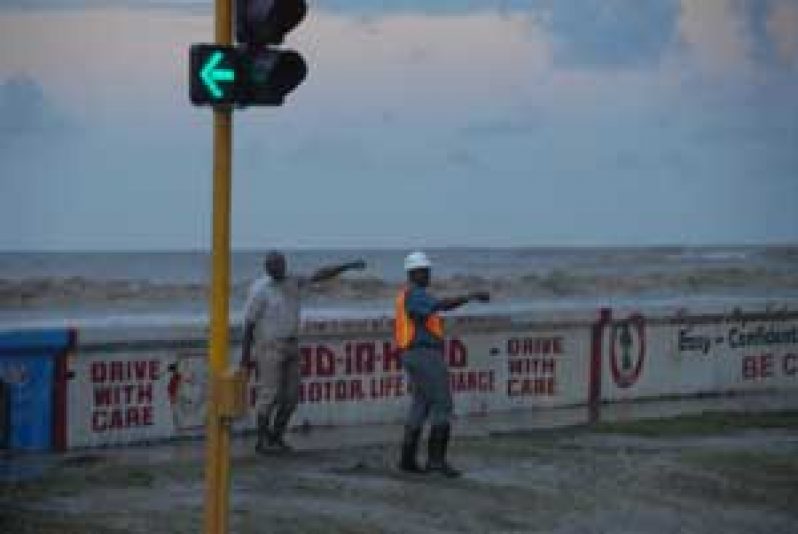UNUSUALLY high spring tides yesterday afternoon caused widespread overtopping of sections of the Georgetown and East Coast Seawalls, by the raging waves of the Atlantic Ocean, which created a furore along the main East Coast thoroughfare, disrupting the flow of traffic and flooding the yards of residents and business places.
The spring tides, fuelled by what
appeared to be a storm out in the ocean, saw howling waves, with no respect for anything in its path, rushing across  the Atlantic, picking up steam as they approached land, and dumping large bodies of heavily silted water onto the main road, and quickly filling nearby yards and trenches.
the Atlantic, picking up steam as they approached land, and dumping large bodies of heavily silted water onto the main road, and quickly filling nearby yards and trenches.
The overtopping began abound 16:30 hrs, in the height of the late afternoon ‘rush hours’, when the bulk of the workforce and school populations plying between Georgetown and the East Coast were making their way home.
It was an almost eerie situation along the East Coast carriageway yesterday, with the situation growing progressively worse with each passing moment. Within the first 15 minutes or so, water had accumulated heavily on the East Coast highway, between Sheriff Street and the Turkeyen Access road. The police were alerted, and traffic ranks were hurriedly deployed to the affected areas, to direct traffic and point motorists to safer routes, amidst a chaotic traffic scene caused by the flooded East Coast road.
Bearing the brunt of the calamity and suffering heavy losses were the Ocean View Hotel and neighbouring buildings onto which the murky waters were deposited, and persons whose yards were quickly flooded.
As persons in the city learnt of the development, there was a mad scamper by both private motorists and commuters to get out of the city, and head home.
Transport and Hydraulics Minister, Robeson Benn, accompanied by a team of officials from the National Drainage and Irrigation Authority yesterday afternoon visited the areas affected by the spring tides.
Minister Benn said the flooding was a result of higher than usual spring tides, measuring 3.15 metres, and high waves  striking a key part of the coast, north of the seawall between Turkeyen and Sheriff Street which is undergoing cyclical erosion.
striking a key part of the coast, north of the seawall between Turkeyen and Sheriff Street which is undergoing cyclical erosion.
“It’s lower and the seawall is at an angle to the transit of the waves. On top of that we had 1.2 metres of waves riding on top of the tide,” he was quoted by the Government Information Agency (GINA) as saying.
GINA reported that the Liliendaal Pump Station was shut down as a precautionary measure due to the massive amounts of garbage floating around. Once the tides, which are the highest thus far for the year, begin to recede, workers, who were on standby, will be clearing the pump’s intakes to commence drainage operations.
“Hydromet officials will check to see if there are any conditions out to sea that are adding to this,” Minister Benn said. He expressed the hope that most of the sea water would be contained in the canals south of the Rupert Craig Highway.
A few years ago, similar flooding occurred between the Better Hope and Montrose communities as a result of overtopping.
Persons are being advised to take the necessary precautions to protect their properties from floodwaters. Motorists are also advised to wash their vehicles thoroughly if they had to transit areas flooded with sea water which can cause corrosion.
Reports at press time last night indicated that the floodwaters have receded.



.jpg)










